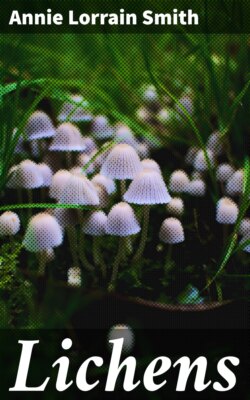Читать книгу Lichens - Annie Lorrain Smith - Страница 70
На сайте Литреса книга снята с продажи.
B. Special strengthening Structures
Оглавлениеa. Sclerotic strands. This form of strengthening tissue is characteristic of Ramalina. With the exception of R. thrausta (more truly an Alectoria) all the species have a rather weak cortical layer of branching intricate thick-walled hyphae, regarded by Brandt[377] as plectenchymatous, but more correctly by Hue[378] as “decomposed” on account of the gelatinous walls and diminishing lumen of the irregularly arranged cells.
Fig. 62. Ramalina minuscula Nyl. A, transverse section of frond × 37; B, longitudinal strengthening hyphae of inner cortex × 430 (after Brandt).
In R. evernioides, a plant with very wide flat almost decumbent fronds of soft texture, in R. ceruchis and in R. homalea there is a somewhat compact medulla which gives a slight stiffness to the thallus. The other species of the genus are provided with strengthening mechanical tissue within the cortex formed of closely united sclerotic hyphae that run parallel to the surface (Fig. 62). In a transverse section of the thallus, this tissue appears sometimes as a continuous ring which may project irregularly into the pith (R. calicaris); more frequently it is in the form of strands or bundles which alternate with the groups of gonidia (R. siliquosa, R. Curnowii, etc.). In R. fraxinea these strands may be scarcely discernible in young fronds, though sometimes already well developed near the tips. Occasionally isolated strands of fibres appear in the pith (R. Curnowii), or the sclerotic projections may even stretch across the pith to the other side (R. strepsilis) (Fig. 75 B).
In the Cladoniae support along with flexibility is secured to the upright podetium by the parallel closely packed hyphae that form round the hollow cylinder a band called the “chondroid” layer from its cartilage-like consistency.
b. Chondroid axis. The central medullary tissue in Ramalina is, with few exceptions, a loose arachnoid structure; often the fronds are almost hollow. In one species of Usnea, U. Taylori, found in polar regions, there is a similar loose though very circumscribed medullary and gonidial tissue in the centre of the somewhat cylindrical thallus, and a wide band of sclerotic fibres towards the cortex.
Fig. 63 A. A, Usnea barbata Web. Longitudinal section of filament with young adventitious branch. a, chondroid axis; b, gonidial tissue; c, cortex. × 100 (after Schwendener). B, U. longissima Ach. Hyphae from central axis × 525 (after Schulte).
In all other species of Usnea the medulla itself is transformed into a strong central strand of long-celled thick-walled hyphae closely knit together by frequent anastomoses (Fig. 63 A). This central strand of the Usneas is known as the “chondroid axis.” A narrow band of loose air-containing hyphae and a gonidial zone lie round the central axis between it and the outer cortex (Fig. 63 A, b). At the extreme apex, the external cortical hyphae grow in a direction parallel with the long axis of the plant, but further back, they branch out at right angles and become swollen and mostly “decomposed” as in the cortex of Ramalina.
In Letharia (L. vulpina, etc.) the structure is midway between Ramalina and Usnea: the central axis is either a solid strand of chondroid hyphae or several separate strands.
Fig. 63 B. Usnea longissima Ach. A, transverse section of fibril × 85. B, a, chondroid axis; b, gonidial tissue; c, cortex × 525 (after Schulte).
In three other genera with upright fruticose thalli, Sphaerophorus, Argopsis and Stereocaulon, rigidity is maintained by a medulla approaching the chondroid type. In Sphaerophorus the species may have either flattened or cylindrical branching stalks, but in all of them, the centre is occupied by longitudinal strands of hyphae. Argopsis, a monotypic genus from Kerguelen, has a cylindrical branching thallus with a strong solid axis; it is closely allied to Stereocaulon, a genus of familiar moorland lichens. The central tissue of the stalks in Stereocaulon is also composed of elongate, thick-walled conglutinate hyphae, formed into a strand which is, however, not entirely solid.
